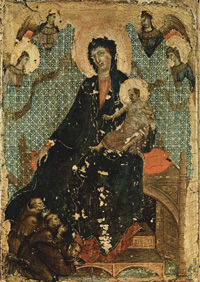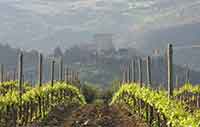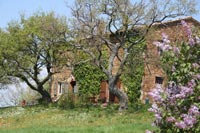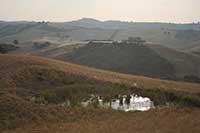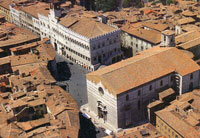 |
Piero della Francesca, Polyptych of the Misericordia, about 1460, tempera and oil on panel, 134 x 91 cm, Sansepolcro, Museo Civico |
Madonna della Misericordia | Madonna of Mercy |
| The Virgin of Mercy is a subject in Christian art, showing a group of people sheltering for protection under the outspread cloak of the Virgin Mary. It was especially popular in Italy from the 13th to 16th centuries, often as a specialised form of votive portrait, and is also found in other countries and later art, especially Catalonia and Latin America. In Italian it is known as the Madonna della Misericordia (Madonna of Mercy), in German as the Schutzmantelmadonna (Sheltering-cloak Madonna), and in French as the Vièrge au Manteau or Vierge de Miséricorde (Virgin with a cloak or Virgin of Mercy). Usually the Virgin is standing alone, though if angels hold up the cloak she is free to hold the infant Christ. The people sheltered normally kneel, and are of necessity shown usually at a much smaller scale. These may represent all members of Christian society, with royal crowns, mitres and a Papal tiara in the front rows, or represent the local population. The subject was often commissioned by specific groups such as families, confraternities, guilds or convents or abbeys, and then the figures represent these specific groups, as shown by their dress, or by the 15th century individual portraits. Usually the image, whether in sculpture or painting, stands by itself, but in the most famous example, the Madonna della Misericordia altarpiece in Sansepolcro by Piero della Francesca, of 1445-62, the subject is the central panel of a large altarpiece, with a smaller Crucifixion above it, and many other panels. Probably the oldest version known is a small panel by Duccio of ca. 1280, with three Franciscan friars under the cloak.[1] Here the Virgin sits, only one side of the cloak is extended, and the Virgin holds her child on her knee with her other hand. |
Duccio, Madonna of the Franciscans |
||
 |
||
Duccio, Madonna of the Franciscans, c. 1300, tempera on wood, 23,5 x 16 cm; Pinacoteca Nazionale, Siena |
||
| Little is known of his life, but several commission records survive, as well as two documented works, the Rucellai Madonna for the Florentine church of Santa Maria Novella (1285) and the famous Maestà altarpiece for Siena Cathedral (1308 – 11); both represent landmarks in the history of Italian painting. He was the leading painter in Siena, one of Italy's most vital artistic centres in the Middle Ages. Duccio, Madonna of the Franciscans, ca 1280, the earliest known painting of the subject. The Madonna of the Franciscans shows structural articulation, and was probably part of a diptych or triptych intended for private worship, perhaps of a small group of Friars Minor. Iconographically it follows the "Madonna of Mercy" type: while looking towards the spectator the Virgin holds back the edge of her robe the better to receive and protect the three kneeling friars, for whom the Child's blessing is intended. This elaborate intermingling of echoes from Cimabue and Byzantine art, with the added softness of Duccio's personal touch, includes elements of the new artistic language from beyond the Alps. The tiny square panels of the backcloth, an innovation substituting the usual gold ground, are of clear French derivation. Thus, the measured breadth of contour, the sinuous curving of the robe's hem and the smooth masses of colour form part of a wider spatial dimension, where the Gothic predilection for linearity and flowing outlines reaches its maximum expression. The features of the supplicating friars and the throne, a simple wooden seat placed obliquely to create an effect of perspective, reflect the teaching of Cimabue. The unusual posture of the Child's legs belongs entirely to Duccio, however, who repeats the gestures of the early Madonna of Buonconvento and the Rucellai Madonna. |
||
| Simone Martini, "Madonna della Misericordia" (Madonna of the Protecting Coat). From the Parish Church of Vertine. Tempera on wood, 154 x 88cm. | ||
| The Triptych was painted between 1415 and 1436 with the earlier of the two dates the more probable given the affinity of this work with the style of the 'Stories of Santa Lucia' in the Pinacoteca at Fermo. If the appearance of the lateral saints - St. John the Baptist and St. John the Evangelist - is still somewhat forbidding, and if they seem still to be firmly part of the world of the 1300s, the centre is occupied by the Virgin presented as an extremely elegant, divine idol, surrounded by crowds of devotees, the costume and physical attitude of each of which is rendered through an extremely subtle use of light and colour. Jacobello del Fiore was a Venetian painter, who broke away from the Byzantine tradition exemplified by Paolo Veneziano which dominated Venetian art until the end of the 14th century. He was in turn influenced by the Intenational Gothic style of the early 15th century. Most of his works are in Venice. |
Jacobello del Fiore, Triptych of the Madonna della Misericordia c. 1415 Tempera on panel, 86 x 113 cm Gallerie dell'Accademia, Venice |
|
Piero della Francesca | Polyptych of the Misericordia 1445-1462 |
||
 |
||
Piero della Francesca, Polyptych of the Misericordia, about 1460, tempera and oil on panel, 134 x 91 cm, Sansepolcro, Museo Civico |
||
| The Polyptych of the Misericordia is one of the earliest works of Piero della Francesca, located in the Pinacoteca Comunale of Sansepolcro. Piero della Francesca was an Italian artist who also was an accomplished mathematician and geometer. His mathematical knowledge influenced his art as evidenced by his use of foreshortening, geometric forms and innovative perspectives. The cool colour palette and geometrical compositions contribute to the refined and meditative nature of his works. Piero was born in Borgo Sansepolcro, in Tuscany. He worked in various central Italian towns, but retained links with Sansepolcro. Here Francesca features the Madonna as the centerpiece of the polyptych, flanked by the Virgin of the Annunciation, various saints, and images of the life of Christ. The piece was commissioned in 1445 by the Compagnia della Misericordia and was completed in 1462. This painting contains a self-portrait of the artist, third from the left, kneeling at the feet of Mary. 'A distinctive feature of Sansepolcro was the prominence of confraternities in its civic and sacred life. 16 Confraternities, which to this day survive in the town, were organizations of lay people who dedicated themselves to imitating Christ’s example through their philanthropic activities and religious devotions. 17In Sansepolcro, there were seven confraternities that sang laude(songs of praise and mourning) to the Virgin, Christ, and saints. 18 These laudesi (laud-singing) companies were complemented by seven confraternities of disciplinati (flagellants). Disciplinati flagellated themselves in imitation of Jesus’s suffering before the Crucifixion, when he was stripped of his garments, spat upon, and whipped, thereby hoping to expiate the sins of humanity. 19Confraternities often combined the devotional practices of both types. As in other towns, the confraternities of Sansepolcro safeguarded public welfare. They administered hospices for pilgrims, homes for the indigent, hospitals for the sick, and orphanages for foundlings. They distributed food and clothing to the needy, and they offered solace to prisoners. In so doing, they were following Jesus’ example. Caring for the impoverished, tending the sick, comforting prisoners, and providing hospitality to strangers were among the seven acts of mercy prescribed by Jesus in Matthew 25:34–37as prerequisites for salvation. Through their benevolence and performance of other pious activities – ritual flagellation, the singing of laude, attendance at weekly and special masses in confraternal chapels and churches – members were deemed, in their own eyes and those of the community, worthy of divine mercy at the Last Judgment. Even after death, their souls in purgatory were thought to accrue merit through the good works of surviving brethren. The guarantee of such benefits inspired many to become members or to make bequests to confraternities, especially in the wake of the Black Death (1348–50).' [1a] Art in Tuscany| Piero della Francesca | Polyptych of the Madonna of Misericordia (1445-1462), Sansepolcro |
 |
|
Sano di Pietro | Madonna of Mercy |
||
 |
||
Sano di Pietro, Madonna of Mercy, ca. 1440. Private collection |
||
 |
||
St. Maria delle Grazie with the High altar of Andrea Della Robbia, containing the image of Madonna della Misericordia painted by Parri Spinello
Lippo Memmi, 1350s. "Madonna of Mercy" by Lippo Memmi (1320); Chapel of the Blessed Corporal; Cathedral of Orvieto, ItalyThe couple at the front were probably the donors.
|
||
The village church of Cercina, near Florence, has a fresco of three saints, now thought to be Ghirlandaio's earliest work, but there is general agreement that some frescoes in the church of Ognissanti in Florence, almost certainly dating from around 1472-73, show his style at its earliest developed stage. One of them represents the Pietà and depicts several members of the Vespucci family as mourners, thus already introducing Ghirlandaio's characteristic combination of portrait figures in contemporary dress with a specifically religious subject. "His first paintings were in the Chapel of the Vespucci at Ognissanti, representing a dead Christ and some saints, and a Misericordia over an arch, containing a portrait of Amerigo Vespucci, who navigated the Indies..." (Vasari). The Madonna della misericordia fresco in the Vespucci chapel, by Domenico Ghirlandaio with his brother David, of the Madonna della Misericordia protecting members of the Vespucci family, is reputed to include the portrait of Amerigo Vespucci as a child and Simonetta Vespucci (blond with uncovered hair). The date of the chapel's construction is 1472. We can date the frescoes immediately afterward. In these Ognissanti frescoes the inspiration of Baldovinetti is marginal; more obvious are certain elements acquired from Andrea del Castagno and some clear, vivid colours that are reminiscent of Domenico Veneziano. Most interesting, however, is the artistic personality of Ghirlandaio himself, so well defined at this early age, and that attentive observation of man in every physical and interior detail that made him such an able portraitist. Here is the old man, probably the head of the family, seen from behind, kneeling, solidly built, his lean face with its hard features softened by the whiteness of his fine hair. The older woman in a cloak stands out in a contrast of lights and colours. Serenely clear, on the other hand, is the younger woman, with her hair gathered into plaits and her ample forehead shaved back according to the Florentine fashion of the time. The expression on the face of the boy, thought to be Amerigo Vespucci, is intense; his face, with its full lips and large clear eyes, is still chubby, pinkish and childlike. Domenico's attention seems to have lingered on the figures, perhaps in prayer, right there in Ognissanti, his brush faithfully reproducing and individualizing the features of each of them. |
||
| Pietro da Montepulciano di Domenico probably took his name from the village of Montepulciano in the Marches and not from the town in Tuscany. Pietro di Domenico was active in the Marches during the first quarter of the fifteenth century, but his reputation may have extended elsewhere. The polyptych of the Virgin and Child with Saints (1418; Osimo, Mus. Sacro Dioc.), painted for the baptistery at Osimo, is his first dated work. Its composition is still in the style characteristic of 14th-century painting of Umbria and the Marches, although it also suggests that the artist may have been influenced by the Venetian figurative style. This is confirmed by other panels, such as the Coronation of the Virgin (Washington, DC, Howard U., Gal. A.), the Virgin and Child with Saints (Hannover, Nieders?chs. Landesmus.) and the Madonna of Mercy (Avignon, Mus. Petit Pal.). These paintings, in which form is created by means of soft shading, recall the work of Jacobello del Fiore in the Marches. |
 Pietro di Domenico da Montepulciano, La Virgen de la Misericordia, Avignon, musée du Petit Palais Pietro di Domenico da Montepulciano, La Virgen de la Misericordia, Avignon, musée du Petit Palais |
|
Oratory of the Company of Saint Catherine of the Night |
||
| The Oratory of the Company of Saint Catherine of the Night, located in the heart of the Santa Maria della Scala complex [3], where St Catherine used to stop in prayer and comforted the sick, still conserves the same intensity and atmosphere that for many centuries have accompanied the religious fervour of the Saint’s countless devotees. Known since the Fifteenth century as the Confraternity of St Michael, the company devoted itself mainly to pietas towards the dead. In fact it was based near the Hospital’s cemetery and the so-called carnaio (charnel house) with a chasm that from the upper floor at the same level as Piazza del Duomo sank down to the much lower level of Piazza della Selva. In the Seventeenth century the Oratory was enriched with many stuccos and paintings, including four paintings on canvas depicting Saint Catherine’s life to be attributed to Sienese painters Rutilio Manetti and Francesco Rustici. An interesting 14th-century marble Madonna on the altar is probably the Company’s oldest cult image and is surrounded by four angels along with Saints Domenico and Catherine in adoration. Besides the numerous paintings, carvings, reliquaries and decorations, the company conserves a beautiful table by Taddeo di Bartolo portraying the Madonna with Child, Four Angels and Saint John the Baptist and Saint Andrew, dated 1400 and four coffin heads with Saint Catherine Protecting Four Brothers Under Her Mantle, Risen Christ, the Stigmata of the Saint and the Deposition, attributed to a Sienese artist of the first half of the Sixteenth century. |
 St Catherine of Siena protects some of the Confraternity of the Night Oratory, on a 16thC coffin panel (one of four, attributed to Benevuto di Giovanni). Maybe from Oratorio di Santa Caterina della Notte. Known since the Fifteenth century as the Confraternity of St Michael, the company devoted itself mainly to pietas towards the dead. [2] |
|
Hans Memling brugge |
||
Madonna with Child and Saint Dominic; Convent of the basilica of Saint Dominic, Bologna, Italy |
||
| La Madonna della Misericordia con i Santi Lorentino e Pergentino' | Parri di Spinello, La Madonna della Misericordia con i Santi Lorentino e Pergentino' |
|
Gaspare da Ponderano, Madonna of Mercy and Pietà, XVI century, St Peter church, Benna (Biella) |
||
| Madonna of Misericordia Girolamo di Giovanni about 1449-1473 Panel, 206 x 125 cm Camerino, Museo e Pinacoteca Civica |
||
| Situated on the corner of the piazza of the Duomo and via Calzaioli, the mid-14th century Loggia del Bigallo has been a small museum since 1904. Even from outside, you can admire the frescoed building, but heading inside will give you a chance to see the much deteriorated but famous fresco of the Madonna della Misericordia, an image of the Virgin Mary with her cape encompassing her devotees (in this case the entire city) who are surrounded underneath and around her. The Bigallo Madonna is depicted with the oldest known view of Florence, from 1352. Since 1998 the Loggia del Bigallo has been run by the Museo of the Opera del Duomo. Its beginnings, however, were as the main seat of the Misericordia, a catholic confraternity founded in Florence in the 13th century to help those in need, which at the time consisted of mostly people affected by the Plague. The Madonna of Mercy (Misericordia) was painted by the Bernardo Daddi school in 1342 in the building now dedicated to the Bigallo orphanage, and which had been the Misericordia Confraternity. Across from it the newer headquarters of the Misericordia still dispense medical care and run ambulances. The members of the Misericordia had laid the first stone of Florence's Cathedral seven hundred years ago. Every Maundy Thursday the Cardinal of Florence washes the feet of eleven Misericordia workers. This fresco is one of the most important keys for unlocking the vocation and for deepening the meaning of Florence. The Madonna wears a crown like that of the Empress Matilda, with the saving Tau in blood, and it is she who protects the city with the weapons of the acts of mercy as Jesus had listed them in the Gospel, these acts being given in the medallions of her mantle that contain these words. [4] This fresco, painted on a wall of the Room of the Captains, is the oldest known representation of Florence, showing its mediaeval towers and monuments, including the Baptistery and an interesting view of the Cathedral during the construction of Santa Maria del Fiore. |
||
 |
||||
The Bigallo Madonna della Misericordia is depicted with the oldest known view of Florence, from 1352. |
||||
Images | www.umilta.net/bigallo |
||||
|
||||
| Wine regions | Podere Santa Pia |
Podere Santa Pia, view from the garden on the valley below |
||
 |
||||
Montefalco |
Sansepolcro |
|||
Vasari Corridor, Florence |
Perugia |
Florence, Duomo |
||
 |
||||
Crete Senesi, surroundings of Podere Santa Pia |
||||
| Podere Santa Pia is located in south of the ‘Crete Senesi’, a beautiful clay hills landscape which is an ideal starting point to discover Tuscany. The guesthouse is located in Castiglioncello Bandini, a charming medieval village situated on a hill, which offers a spectacular view on the Valle dell’Ombrone and the Maremma. Montalcino, the abbey of Sant'Antimo, Pienza and the Crete Senesi with Asciano, Buenvonvento and the Abbey Di Monte Oliveto Maggiore are within easy reach. | ||||

